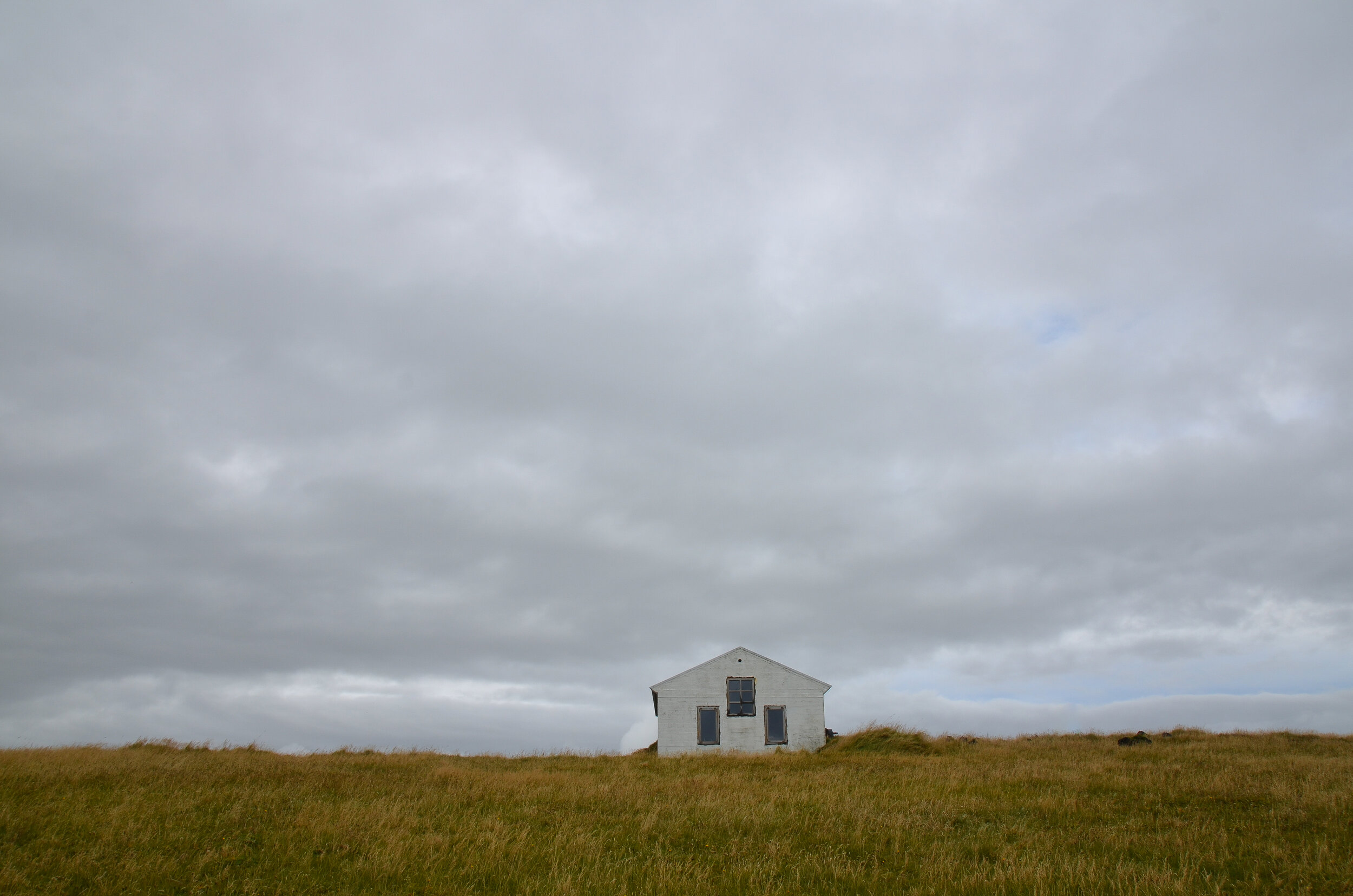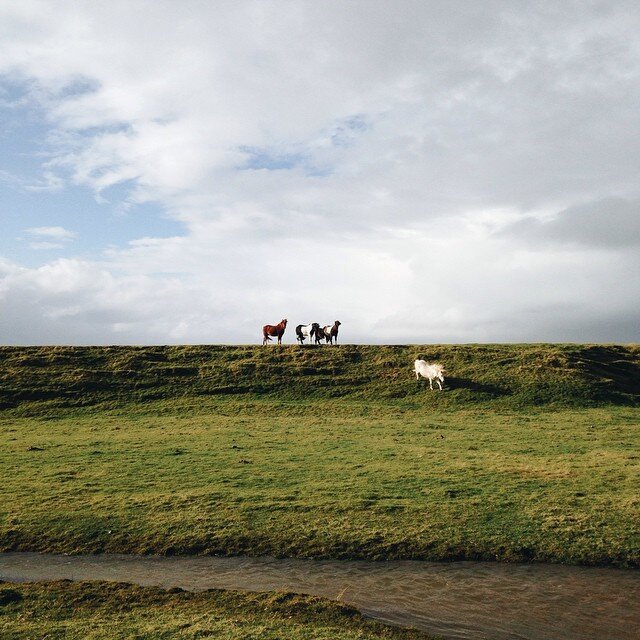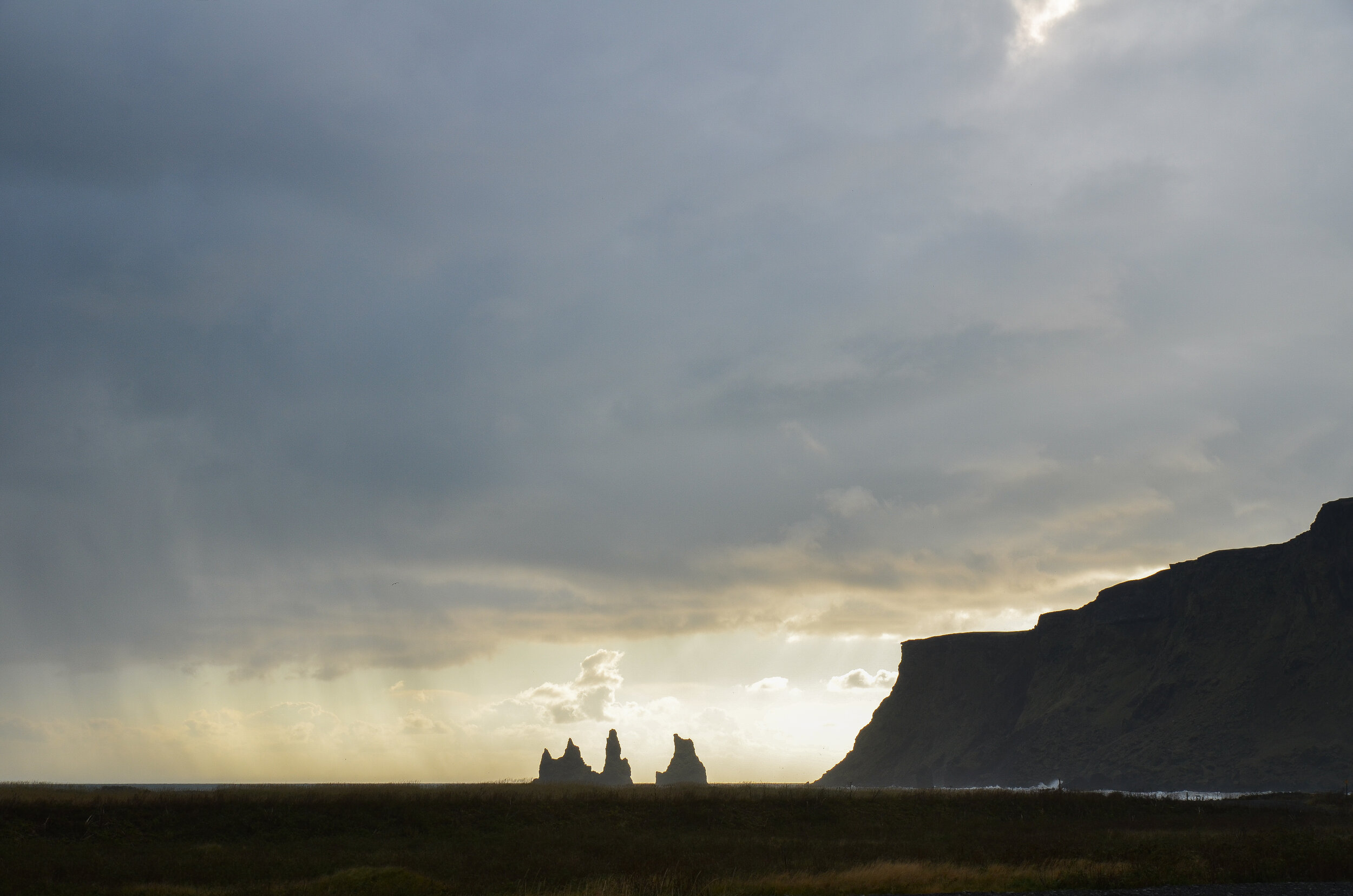Life Off the Ring Road (WOW Air)
Leilah Connor on a hike. All photos by Krista Connor.
What it's like to volunteer on a dairy farm in the land of Fire & Ice
I watched, as the bus pulled from the parking lot onto the road stretching out of Vík í Mýrdal, instantly shrouded by a seam of mist and towering crag. I was alone.
I shifted my backpack, standing outside the gas station which also functioned as a restaurant, gift shop and bus stop, and I glanced down the road in both directions, and waited.
Someone should arrive at any minute to take me to a dairy farm where I’d work as a volunteer; milking cows would be my main occupation for the next three weeks.
I should point out: I’ve never milked a cow before. In the U.S.A. as writer for an East Coast magazine, it’s probably no surprise I'd never had a chance to do that. But I was on a tight budget and I knew I wanted to spend time living in Iceland, to do more than pass through. Volunteering seemed like the most promising option and would provide a small way to give back, too. The volunteer exchange site Workaway.info – free room and food for a few hours' work a day – provided plenty of options and I narrowed them down to this one outside of Vík.
Finally, two farm volunteers arrived, and we were off, up and down mountainsides into sprawling moors. We pulled into a rugged driveway with a sign for the farm, Mið-Hvoll (hvoll.com), pointing a few kilometers toward the ocean nearby.
A Room With a View
Once we arrived, the two girls left me to unpack. Out my window and miles across the tundra crouched the Mýrdalsjökull glacier, looming in and out of the ever-changing mist: Gone now. Back again. You’d pay a bit at a hotel for that view.
The two volunteers came to get me at 6 p.m., sloppy in stained jeans, hair pulled back in knit hats. I anticipated this and was already in an old flannel and baggy jeans. We walked across an open yard toward the barn, the girls paces ahead, jumping in puddles to splash each other. In a week my older sister Leilah would be joining us from the U.S. I didn’t really mind being the new girl.
A Barnyard Socialite
The sun was level with the horizon when we rounded a corner, and beams of light streaked through the shadows and dust kicked up by the army of cows headed our way. A tall man, who I assumed was the farmer Siggi, was among them. He raised a languid hand in greeting to the girls, offering me a curt nod and “Halló.”
That first night in the barn, I mostly scrambled, slipped, dodged kicks and ducked away from crusty tails.
In my naivety, I figured we’d have to milk the old-fashioned way – by hand – but thankfully there was a much more modern method: portable milking machines.
We’d hang the machine from a pole overhead. Press a few buttons, bend down to the udder and attach four suctioning “teat cups,” eliciting a gross sucking noise. If suction was lost, though, the noise would turn into maniacal gasps and the cups would start flailing. Allowing this to happen in front of the other volunteers, I sensed, was barnyard social suicide.
Personality Goes A Long Way
On top of learning the art of milking, there were 40 cows with distinct personalities to get acquainted with. I learned who to anticipate kicking hooves from, knew to keep my guard up between an evil duo that would step inward and try to smash me with their massive bellies, assessing my milking worth with their steady eyes. Cows are smart animals, I learned. Ultimately, some needed an intervention from Siggi. To those, he’d give a tap across the flanks with an Icelandic shout (“You have four legs, use them!”). Moments later, though, he’d be plucking dried mud off their backs, whispering to them. They loved him, and obeyed his every command.
Milking would only take about an hour, and by dark we’d be pushing the hay barrel around for their dinner. During that time I loved looking out the old barn windows at the lighthouse on Dyrhólaey, a cliff jutting into the ocean a few miles up the coast. It was a popular photo stop for tourists. But for us, it was just part of the neighborhood. Whether the stars and aurora borealis shone or the ocean raged and rain slashed through the sky, the tower's light never failed in its comforting nighttime orbit.
Getting the Swing of Things
One day, a group of family members including Siggi’s mother Guðný, the farm's manager, and teenage sister Jakobina dropped in from their homes off the farm.
That night, Guðný came down the walkway, with strong arms on her hips inspecting each stall like a sergeant in soldiers’ barracks. I was squatted quietly next to a cow, intent on applying the teat cups. Guðný hovered. I hoped a cup wouldn’t slip and make the dreaded noise. None did.
“You look like you have done nothing else your whole life!” she said.
“You should have seen me two days ago.”
“Ah, two days ago is two days ago,” she said matter-of-factly, and moved on down the row.
I realized I was grinning stupidly at the compliment. Somehow, between the awkwardness of living with strangers and feeling slightly lost, I was slipping into life on the farm.
The Kingdom of "Secret" Places
The work, while dirty, wasn’t an overload, and other than cleaning a handful of on-site farm-stay tourist cabins, we were free to do as we liked. We could always visit local attractions such as Skógafoss waterfall, Mt. Reynisfjall, Dyrhólaey and the town of Vík, but by living with Icelanders, then, in 2014, we had a key to the kingdom of “secret” places. Places that are becoming less and less secret with the continuing influx of tourists. (One and a half million are expected in 2016 in this nation of 323,000 citizens).
When Guðný drew a map in the air of a remote pool at the base of the glacier, the two volunteers and I immediately headed for Seljavallalaug, a man-made pool with water flowing into it from natural hot springs.
We forded small streams before spotting it, nestled at the base of a mountain; waterfalls flowed all around. Vast lava fields surrounded us, and the place felt like it was new and alive. Like the famed Icelandic sweater pattern, jagged layers of white snow, brown earth and green moss graced the necks of mountains that formed a watchful semi-circle around us.
When we got back, Guðný asked us about the adventure. She was baking a chocolate cake and scrubbing singed and split sheep heads, known as svið, a traditional dish, prepping them for dinner. Like any mother in any kitchen in any part of the world, I think she was humming.
The Icelandic Horse
The farm also had horses for riding tours on the beach, and one weekend Jakobina and the two volunteers – all experienced riders – were eager for a ride.
The girls selected younger, wilder horses, not placid ones for tourists. Icelandic riding style is unique, too, and the Icelandic horse, which is short and stocky (its size is deceptive – it’s all muscle and force) uses a gait that keeps you bobbing helplessly and jarred, if you don’t know what you’re doing.
We began with a walk toward the beach, but once hooves hit sand, one of the horses began to run. The others started to follow, kicking up globs of black sand, and it was impossible to stop them.
“Wait, what do I do?” I shrieked to the steady backs of my companions. My helmet tumbled over my eyes, and in the jostling I was disoriented, in a half-panic, but I didn’t dare release my death grip on the saddle or reins.
“Just hold onto the saddle with both hands and don’t fall off!” Jakobina yelled. (“When did you start riding?” I asked later. “When I was 3-months-old.”)
The ocean, reflected by the setting sun, was a baffling, shattered sheet of glass. We thundered across a small river; jerked at sharp angles down narrow paths; at any second I knew I could careen into rocks and sand, and yet, I felt ridiculously alive.
Home Away from Home
When my sister joined us on the farm, I could warn her about the evil cows, introduce her to the sweet ones, and take her to the scenic secrets. I watched as she, too, fell in love with the land.
By then, like the others, I stopped washing clothes and jumping into the shower immediately after milking every evening. It just wasn’t practical. I didn’t even bother to change into “normal” clothes for a drive to the shop in Vík.
“Have everything? Let’s go home,” she’d say, and I’d nod, aware of her intended meaning, aware that I didn’t feel the same as that first day I arrived at the shop. Home meant roots, a sense of belonging, if even for a short time.
A couple weeks later, on the morning Leilah and I bid the family farewell and left from that same Vík bus stop, I promised to return, and I meant it; we still keep in contact. Leilah’s already gone back once.
We were grateful, as we rode toward Reykjavik, homeward, past tumbling waterfalls, barren flats, and mountains that staggered into glaciers, which melted into soft sky.





















